
Documenting Japanese War Crimes at Tokyo: The International Military Tribunal for the Far East, 1946-1948
Documenting Japanese War Crimes at Tokyo was the first project to pilot some of WCDI’s ideas. It is an interactive map, using ArcGIS Online, showing the shifting geographical distribution and patterns of war crimes committed by members of the Japanese armed forces as documented by the prosecution during the trial of major Japanese war criminals at the International Military Tribunal for the Far East (IMTFE, 1946-1948).
A Guide to Using the Interactive Map
Sources
The official IMTFE record, including the trial transcripts and exhibits, is retrievable online from the ICC Legal Tools Database. Follow one of the following two links on the ICC Legal Tools website:
“Other International(ised) Criminal Jurisdictions” > “International Military Tribunal for the Far East (IMTFE)”; or
“United Nations War Crimes Commission” > “Member Governments, Other National Authorities and Military Tribunals”.
The specific portion of IMTFE records used to develop this interactive map is “Prisoner of War Appendices A and B,” which the IMTFE prosecution submitted as a supplementary material to its summation on war crimes. The two appendices, which appear at pp. 40114-536 of the transcripts of court proceedings, summarize the evidence of Japanese-perpetrated war crimes against prisoners of war, civilian internees, and other civilian populations in occupied territory across Asia and the Pacific, in the temporal dimension of 1937-1945.
It should be noted that the prosecution’s summary in these appendices is limited to recapitulating the overall picture of Japanese war crimes, but not necessarily to provide an exhaustive list of every single case that the prosecution documented during the court proceedings. Some cases of war crimes are, in fact, not mentioned at all in the appendices, but they may be included in a summary of evidence against specific individual accused. For instance, the summary of evidence concerning the Japanese mistreatment of Doolittle Flyers does not appear in appendices A and B but the summation relating to accused Hata Shunroku (trial transcripts, pp. 40762-75) and accused Tōjō Hideki (trial transcripts, pp. 42019-21). This interactive map reflects only those evidentiary materials that are addressed in appendices A and B.
For Appendices A and B, see the transcripts of court proceedings at pp. 40114-536.
For a guide to the appendices, see R. John Pritchard, et al., eds., The Tokyo War Crimes Trial: Index and Guide (New York: Garland, 1981-7), vol. 3, pp. 1032-7.
The prosecution’s case at IMTFE
Users of this map are alerted to the fact that the documentation of war crimes by the prosecution at IMTFE tended to be more episodic than comprehensive. The lack of comprehensiveness in the prosecution’s case resulted due partly to the massive coverup effort by the Japanese authorities at the war’s end (in the form of burning documents, concocting false stories, and encouraging war criminals to flee), and due partly to the limited time and resources for the prosecution to carry out a full-fledged war crimes investigation before the start of the trial.
To mitigate some of these challenges in the preparation of its case against major Japanese war criminals, the IMTFE prosecution from early on adopted a method of proof by which it would focus on presenting a representative range of “crime-base evidence,” which would be just enough to show the broad geographical distribution and recurrence of similarly-patterned war crimes for the duration of the war. Such evidence, in turn, would enable the judges to infer that the higher ups in the Japanese central government and military chain of command must have ordered or authorized the commission of war crimes or, alternatively, should have known about the widespread war crimes that accompanied the Japanese conduct of war and military occupation and yet did nothing effective to stop them. In addition, the prosecution presented a limited amount of “linkage evidence” – the evidence of criminal orders, authorization, and knowledge – with which to show affirmatively that certain accused were culpable for the occurrence of specific instances of war crimes.
Evidence of orders, authorization, and knowledge
As stated above, the prosecution presented as evidence not only voluminous “crime-base” evidence but also a limited amount of “linkage evidence” that would help establish the link between war crimes and the accused. This interactive map invokes both types of evidentiary materials. Users may take note, especially, of the data points that carry information on “orders and authorization” and “knowledge,” shown in the interactive map by red and pink circles respectively.

Overview of the interactive map and legend.
The evidence on orders and authorization does not always implicate any specific accused at the IMTFE but may point to someone else ranked lower in the government or the military chain of command. The evidence on knowledge consists mostly of diplomatic records that were exchanged between the Japanese and Allied governments via the Protecting Powers concerning the Japanese mistreatment of Allied prisoners of war and civilian internees. As such, they usually carry the names of successive foreign ministers of Japan, as either the recipient or the issuer of the documents concerned, including accused Tōgō Shigeru (foreign minister, 1941-1942, 1945) and Shigemitsu Mamoru (foreign minister, 1943-1945).
Data points, pop-up views, and court exhibits
Based on the prosecution’s summation as it appears in Appendices A and B as explained above, WCDI has identified approximately 1,200 data points and manually entered them into a spreadsheet, which were then transformed into a GIS layer used in this interactive map. Each data point in this map, when clicked, will bring out the essential information about one episode – or one set of episodes – of war crime as recapitulated in the prosecution’s summation, such as, location, date, crime type, victim type, victim nationality, a narrative summary of the case (as provided by the prosecution), and underlying evidence of the case (i.e. court exhibits and/or witness testimony).
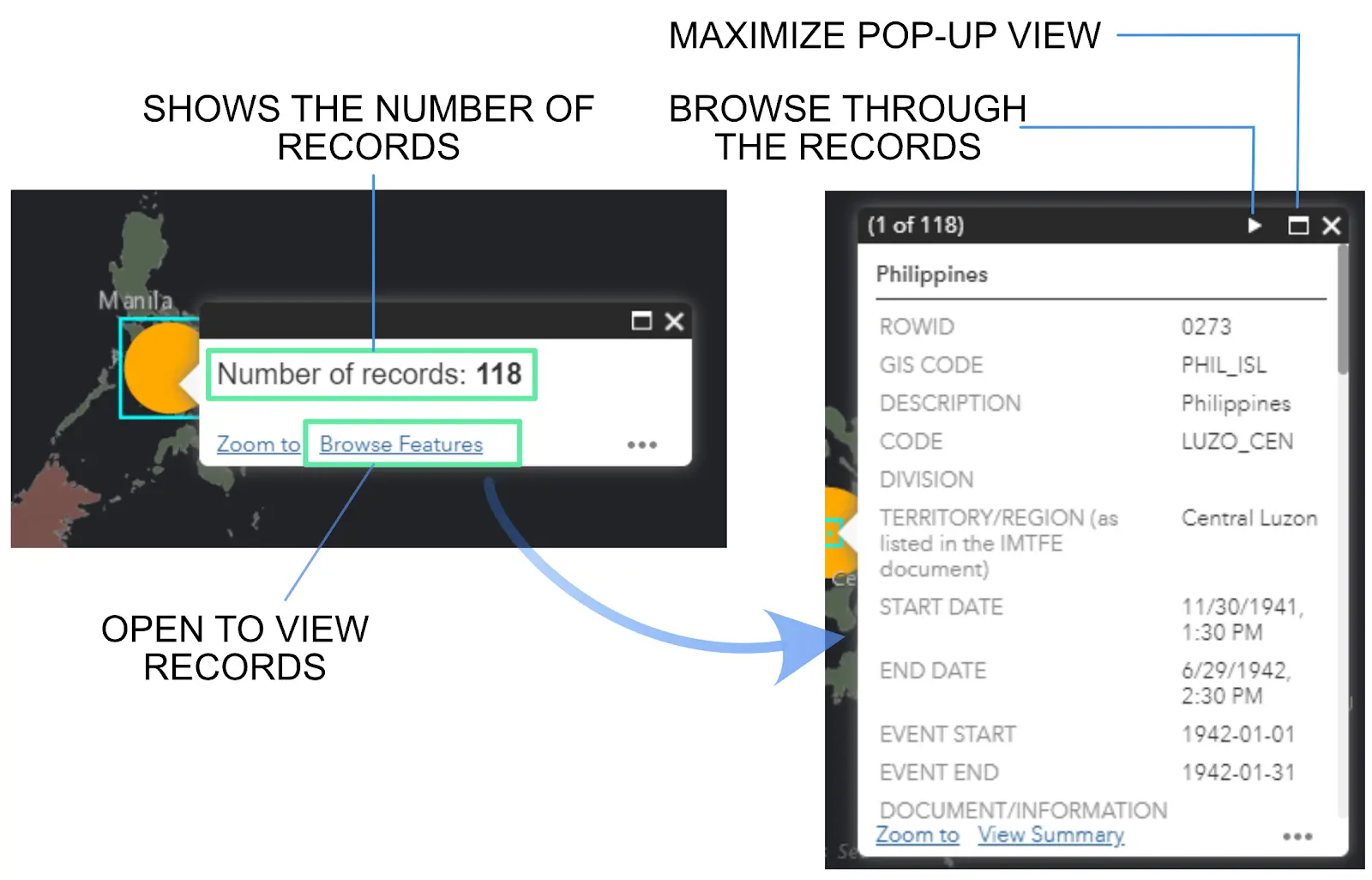
Example popup with metadata on episodes of war crimes.
When court exhibits are available in pdf format, they are appended to relevant data points. Otherwise, court exhibits and witness testimony should be sought in the IMTFE trial transcripts themselves. A selection of pages from trial transcripts that related to war crimes is appended to the interactive map.

Transcripts of court proceedings.

Selection of trial transcripts.
The entry “INDICTMENT REFERENCE” in the pop-up views carries codes that the IMTFE prosecution created to help identify different crime types that the Japanese had committed in violation of which specific articles in the Hague Convention IV (1907) and/or the Geneva Conventions (1929) . The details of the IMTFE prosecution’s coding can be found in “Particulars of Breaches” in Appendix D of the IMTFE indictment.
The entry “SUMMATION” in the pop-up views carries in verbatim the summary of evidence for each episode of war crime that the IMTFE prosecution provided in Appendices A and B. Some summaries are detailed while others are short, and there are also some variations in the types of abbreviations and spelling that the prosecution applied in the summation (e.g. “colonel” vs “col.”; “March” vs “Mar”; “defence” vs “defense”; “jail” vs “gaol”; etc.). In this digital project, editorial intervention is kept at minimum and leaves these stylistic variations largely intact. Users of this interactive map should be aware that these summaries are meant merely as a guide to evidentiary materials (i.e. court exhibits and witness testimony), and that they do not constitute evidentiary materials themselves. It is therefore vital that, after browsing the pop-up views, the users follow links to read the actual court exhibits and witness testimony in the transcripts of court proceedings.
Using the time slider and filters
Users can filter the data points according to dates using the time slider (shown on the right bottom corner) by specifying a date range.

Time slider.
The filter tool is also available for users to search by (1) crime type, (2) victim type, (3) victim nationality / race / ethnicity / geographical origin, or (4) location.

Filter.
The query can also be more specific by combining these variables along with the time slider. Filtering the data or changing the date range will dynamically display the selected records on the map.
Note: Some categories of the crime types as applied in this interactive map may be too general to serve research purposes (such as “beating,” “excessive punishment,” “killing,” “massacre,” etc.) but some other categories can provide vital information concerning the shifting geographical distribution and patterns of the crimes (such as “abduction of women,” “rape,” sexual enslavement,” “sexual violence”).
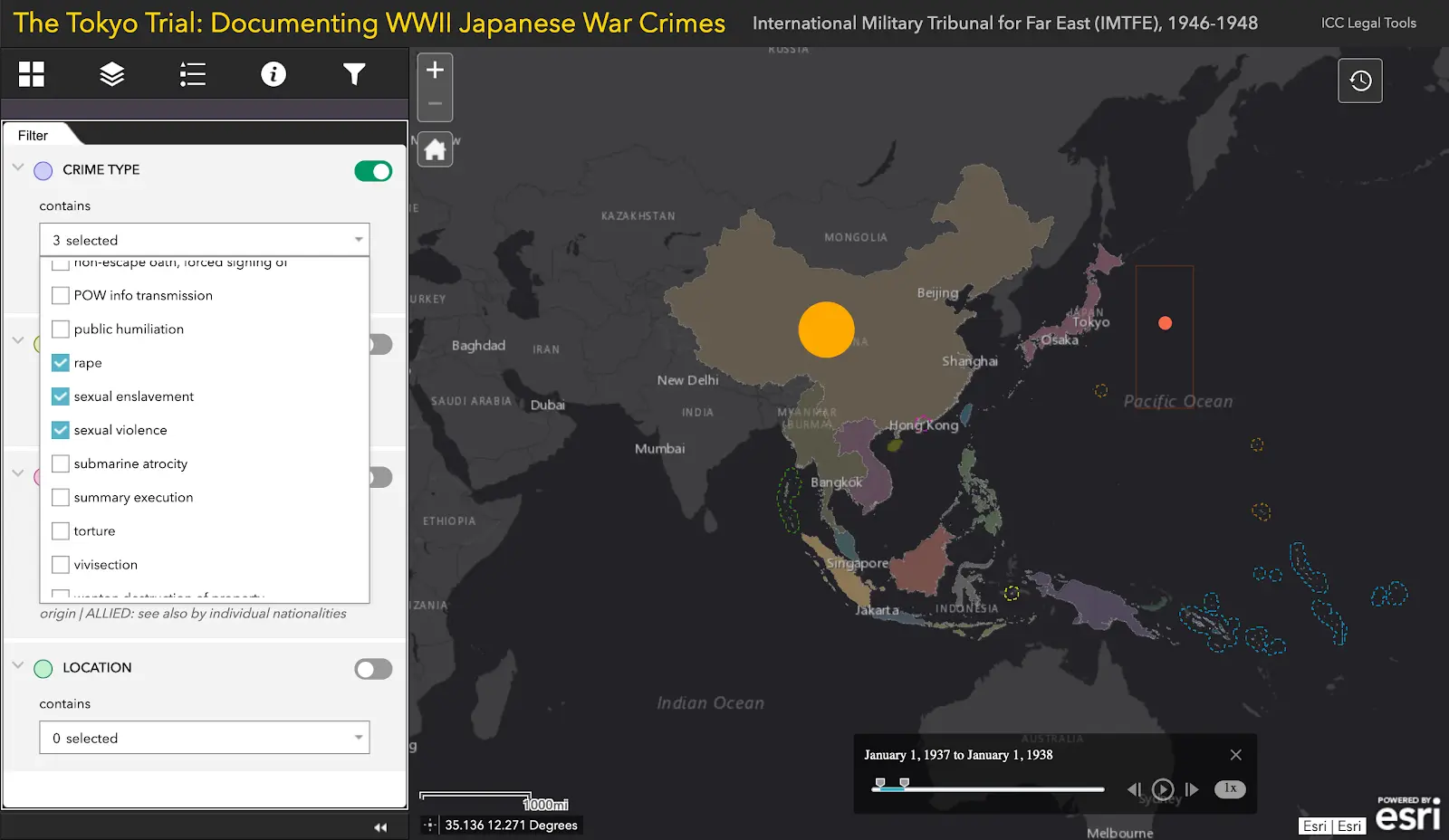
Filtering Crime Type with rape, sexual enslavement, and sexual violence for 1937.
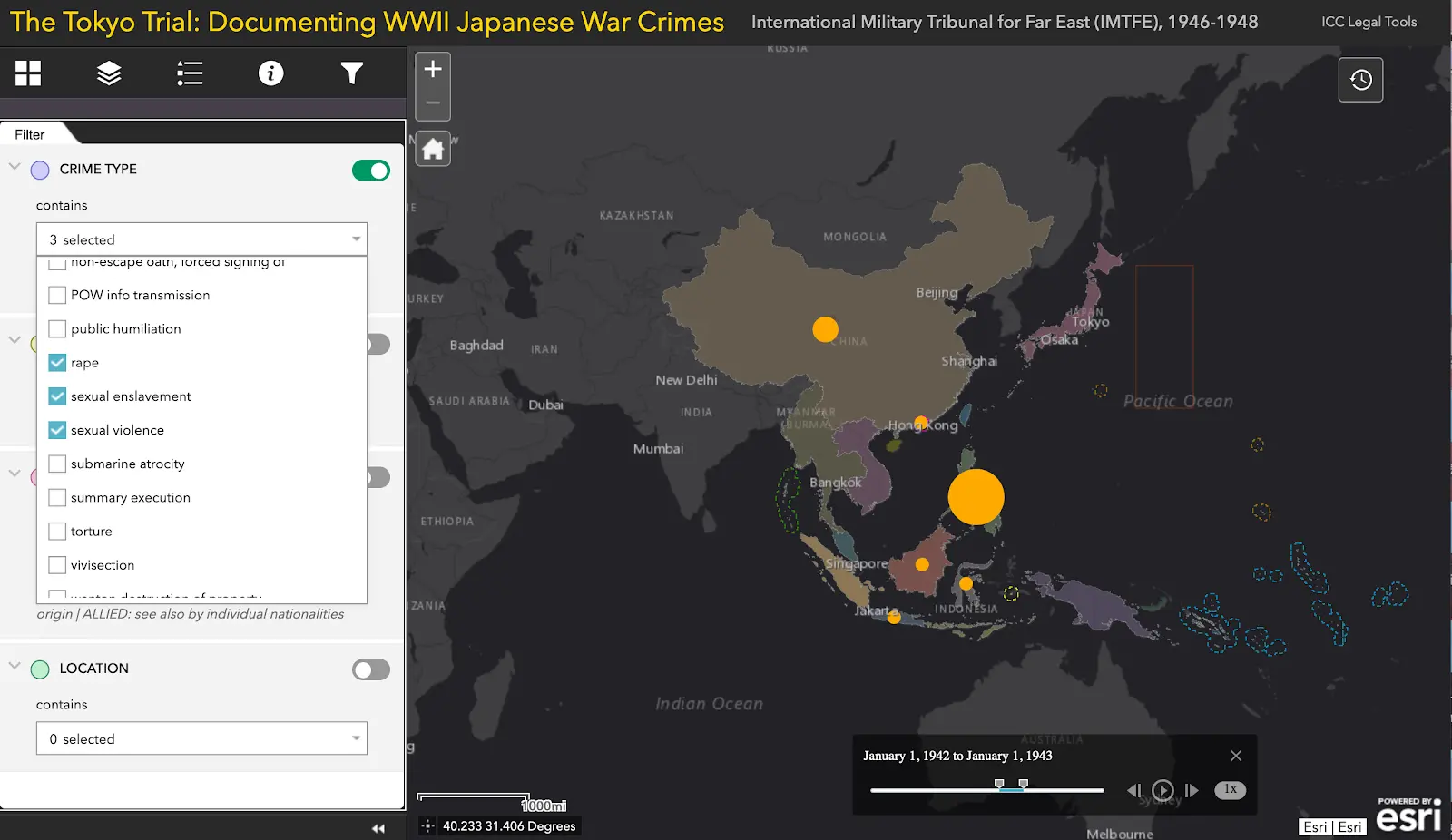
Filtering Crime Type with rape, sexual enslavement, and sexual violence for 1942.
Some of the categories used for the victim nationality / ethnicity / race / geographical origin are ambiguous (such as “Eurasian” and “European”), but some other categories can provide vital information concerning the shifting geographical distribution and patterns of war crimes targeted at specific ethnic groups (such as “Chinese” and “Indians”).
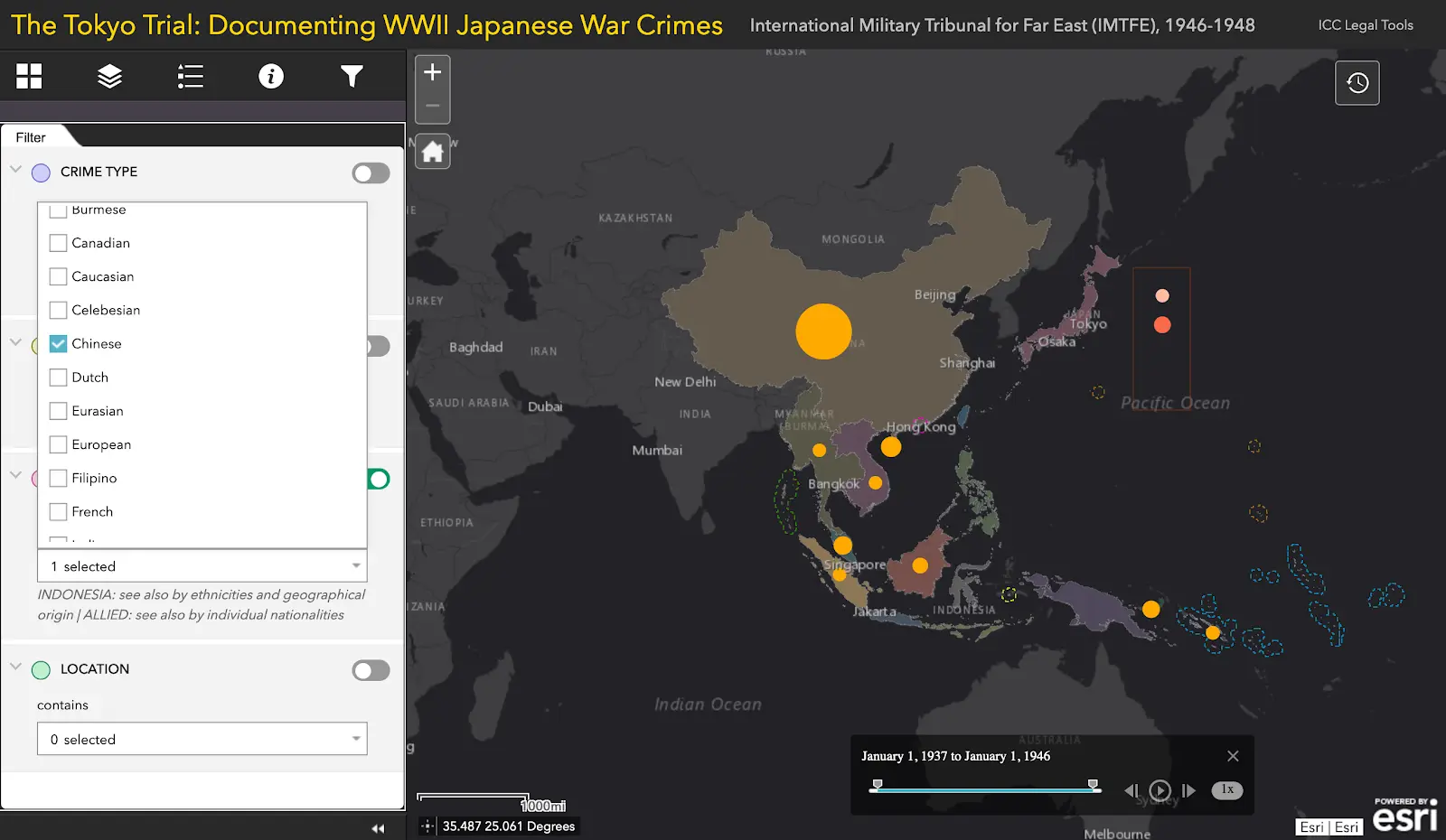
Filtering Victim Nationality / Ethnicity / Race / Geographical Origin with “Chinese” from 1937 through 1945.
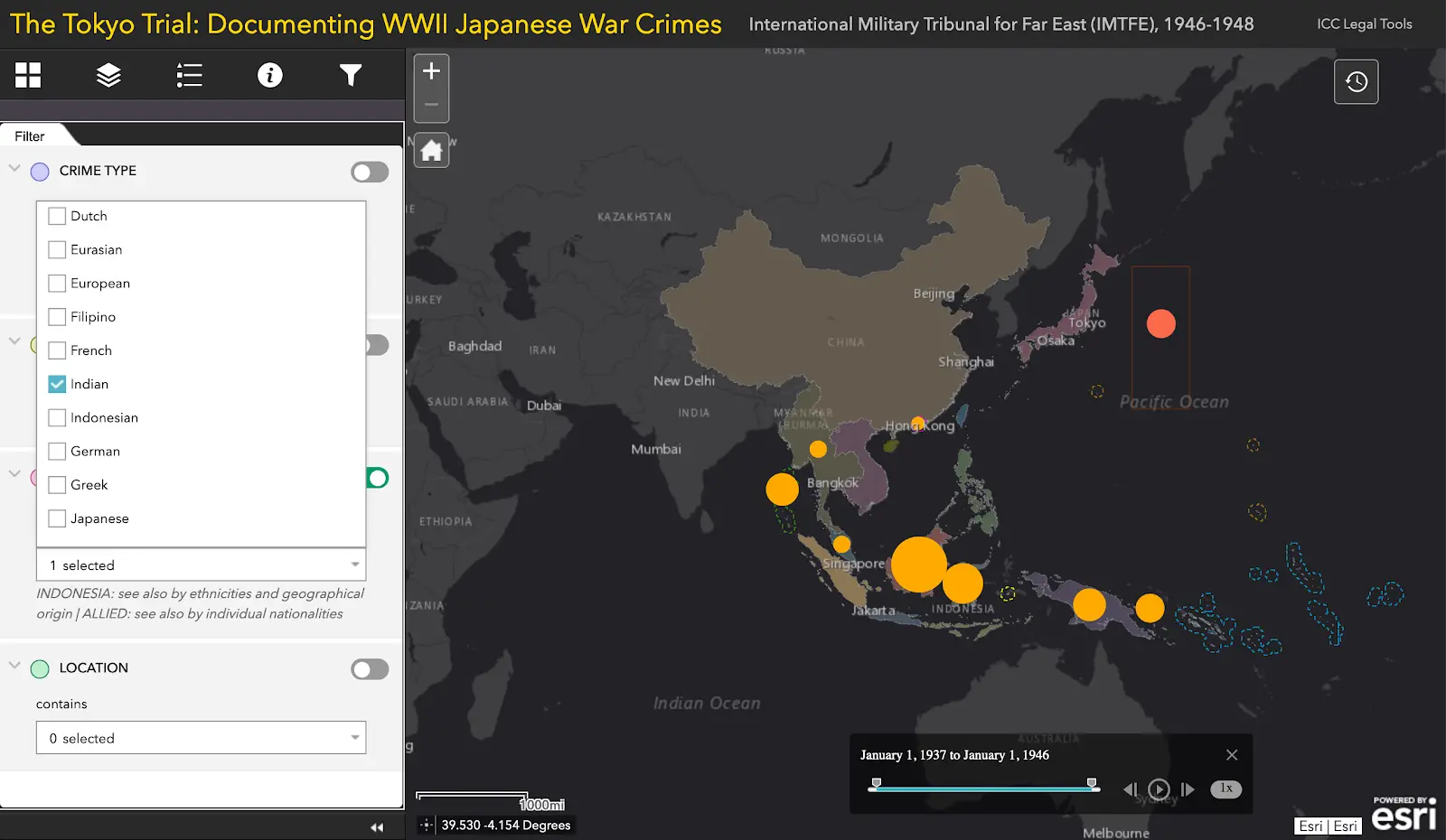
Filtering Victim Nationality / Ethnicity / Race / Geographical Origin with “Indian” from 1937 through 1945.
Similarly, most categories of victim types are broad to serve research purposes although the category, “prisoners of war – airmen,” can reveal vital information concerning the shifting geographical distribution and the increasing frequency of the crimes targeted the Allied airmen in the Pacific theater. That said, the search on the crimes against the Allied airmen will not capture evidence relating specifically to the mistreatment of Doolittle Flyers for the reason that, while such evidence was received by IMTFE and led to the conviction of at least accused Tōjō, it was not part of the prosecution’s summation as shown in Appendices A and B. One can locate the relevant evidentiary materials concerning the Doolittle Flyers case by way of the summary of the prosecution’s case against Hata and Tōjō (trial transcripts, pp. 40762-75 and pp. 42019-21).

Filtering Victim Type with “prisoner of war - airmen” in 1942.
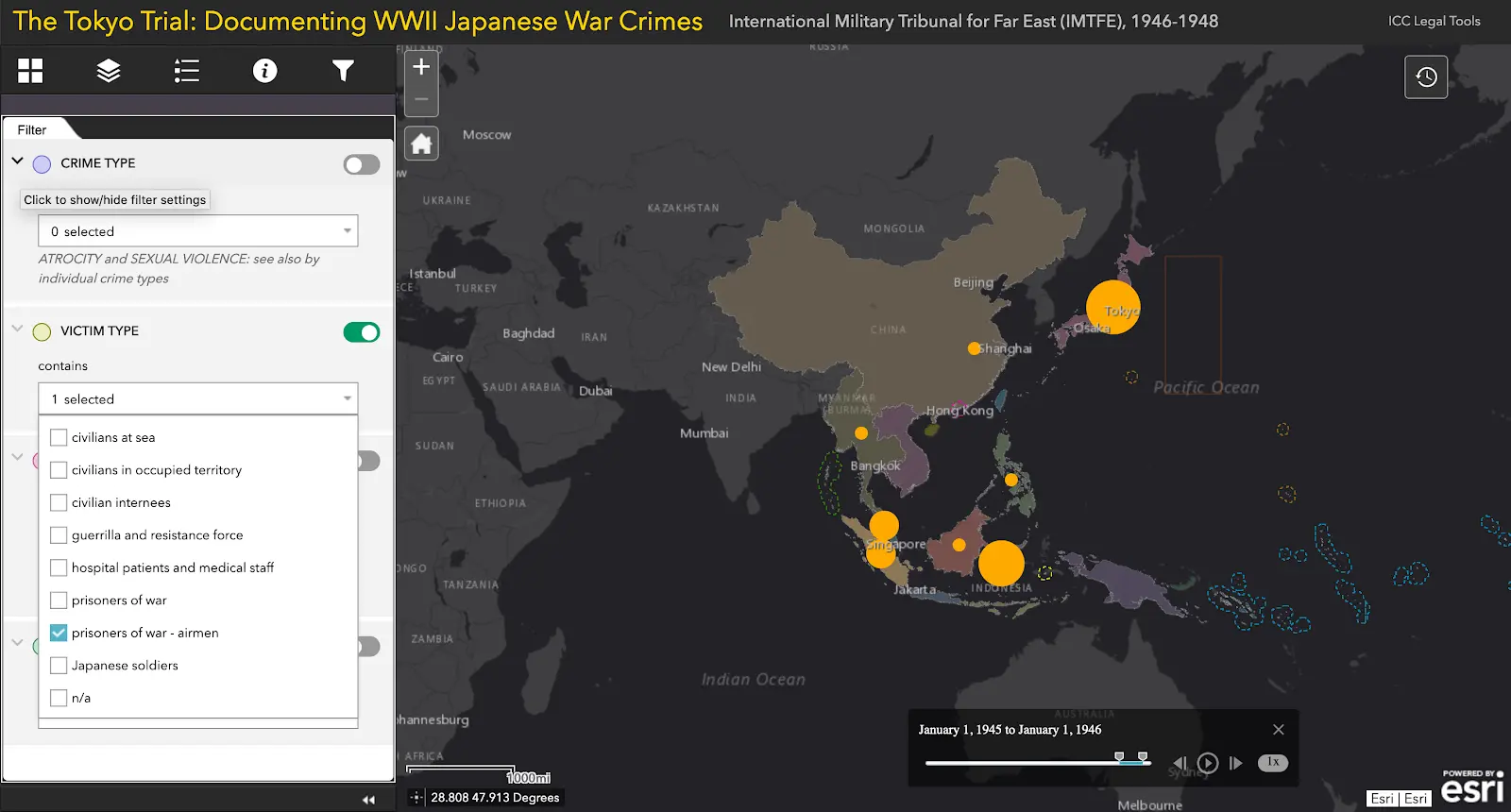
Filtering Victim Type with “prisoner of war - airmen” in 1945.
Abbreviations
The following abbreviations are used in the interactive maps:
- PX = Prosecution’s Exhibit
- DX = Defense Exhibit
- T = Transcript’s Page